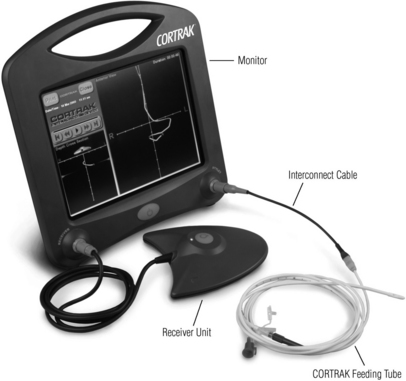PROCEDURE 132 The CORTRAK® system uses electromagnetic technology to enhance the safety of bedside placement of small-bore nasoenteric feeding tubes. The guidance system directs feeding tube placement by tracking the relative location of the tube as it proceeds down the alimentary tract. This visual guidance aids in avoiding intubation of the pulmonary system and facilitates postpyloric placement of feeding tubes.1,5,8,12,15 • Knowledge of upper respiratory and gastrointestinal anatomy and physiology is necessary. • Proficiency is needed in physical assessment skills for lungs and abdomen. • Clinical and technical competence is necessary in placement of small-bore feeding tubes and in use of the CORTRAK® (Corpak MedSystems, Wheeling, IL) device, based on institutional policies. • Recognition is needed of risk factors associated with placement errors during insertion of small-bore feeding tubes: endotracheal intubation, advanced age, altered level of consciousness, and diminished reflexes for airway protection.14 • The benefits of enteral nutrition for the critically ill, including indications for postpyloric placement, should be understood.6 • CORTRAK® feeding tube placement device (Fig 132-1) • CORTRAK® feeding tube with transmitting stylet • 50-mL or larger catheter-tipped or Luer-Lok/slip syringe • Water (tap water or sterile water based on institutional policy) • Additional personal protective equipment, including gown and goggles • Viscous lidocaine (optional) • Water-absorbent barrier to protect patient’s clothing • Explain the essential role adequate nutritional status plays in promoting wound healing and recovery from illness. • Explain why a feeding tube is needed to ensure adequate nutritional intake. • Outline the steps in the procedure and the patient’s role during feeding tube insertion (e.g., position, swallowing as instructed). • Describe the typical sensations experienced during feeding tube insertion. • Inform patient and family of the need for postinsertion radiograph.
Small-Bore Feeding Tube Insertion Using an Electromagnetic Guidance System (CORTRAK®)
PREREQUISITE NURSING KNOWLEDGE
EQUIPMENT
PATIENT AND FAMILY EDUCATION
 Rationale: Explanation may elicit cooperation and allay patient anxiety.
Rationale: Explanation may elicit cooperation and allay patient anxiety.
 Rationale: Explanation may elicit cooperation and facilitate tube insertion.
Rationale: Explanation may elicit cooperation and facilitate tube insertion.
 Rationale: Patient cooperation may facilitate insertion.
Rationale: Patient cooperation may facilitate insertion.
 Rationale: Explanation may alleviate anxiety and promote patient cooperation.
Rationale: Explanation may alleviate anxiety and promote patient cooperation.
 Rationale: Information may provide reassurance regarding expected course of events.
Rationale: Information may provide reassurance regarding expected course of events.![]()
Stay updated, free articles. Join our Telegram channel

Full access? Get Clinical Tree


132: Small-Bore Feeding Tube Insertion Using an Electromagnetic Guidance System (CORTRAK®)

